#urban resilience
Text
As relentless rains pounded LA, the city’s “sponge” infrastructure helped gather 8.6 billion gallons of water—enough to sustain over 100,000 households for a year.
Earlier this month, the future fell on Los Angeles. A long band of moisture in the sky, known as an atmospheric river, dumped 9 inches of rain on the city over three days—over half of what the city typically gets in a year. It’s the kind of extreme rainfall that’ll get ever more extreme as the planet warms.
The city’s water managers, though, were ready and waiting. Like other urban areas around the world, in recent years LA has been transforming into a “sponge city,” replacing impermeable surfaces, like concrete, with permeable ones, like dirt and plants. It has also built out “spreading grounds,” where water accumulates and soaks into the earth.
With traditional dams and all that newfangled spongy infrastructure, between February 4 and 7 the metropolis captured 8.6 billion gallons of stormwater, enough to provide water to 106,000 households for a year. For the rainy season in total, LA has accumulated 14.7 billion gallons.
Long reliant on snowmelt and river water piped in from afar, LA is on a quest to produce as much water as it can locally. “There's going to be a lot more rain and a lot less snow, which is going to alter the way we capture snowmelt and the aqueduct water,” says Art Castro, manager of watershed management at the Los Angeles Department of Water and Power. “Dams and spreading grounds are the workhorses of local stormwater capture for either flood protection or water supply.”
Centuries of urban-planning dogma dictates using gutters, sewers, and other infrastructure to funnel rainwater out of a metropolis as quickly as possible to prevent flooding. Given the increasingly catastrophic urban flooding seen around the world, though, that clearly isn’t working anymore, so now planners are finding clever ways to capture stormwater, treating it as an asset instead of a liability. “The problem of urban hydrology is caused by a thousand small cuts,” says Michael Kiparsky, director of the Wheeler Water Institute at UC Berkeley. “No one driveway or roof in and of itself causes massive alteration of the hydrologic cycle. But combine millions of them in one area and it does. Maybe we can solve that problem with a thousand Band-Aids.”
Or in this case, sponges. The trick to making a city more absorbent is to add more gardens and other green spaces that allow water to percolate into underlying aquifers—porous subterranean materials that can hold water—which a city can then draw from in times of need. Engineers are also greening up medians and roadside areas to soak up the water that’d normally rush off streets, into sewers, and eventually out to sea...
To exploit all that free water falling from the sky, the LADWP has carved out big patches of brown in the concrete jungle. Stormwater is piped into these spreading grounds and accumulates in dirt basins. That allows it to slowly soak into the underlying aquifer, which acts as a sort of natural underground tank that can hold 28 billion gallons of water.
During a storm, the city is also gathering water in dams, some of which it diverts into the spreading grounds. “After the storm comes by, and it's a bright sunny day, you’ll still see water being released into a channel and diverted into the spreading grounds,” says Castro. That way, water moves from a reservoir where it’s exposed to sunlight and evaporation, into an aquifer where it’s banked safely underground.
On a smaller scale, LADWP has been experimenting with turning parks into mini spreading grounds, diverting stormwater there to soak into subterranean cisterns or chambers. It’s also deploying green spaces along roadways, which have the additional benefit of mitigating flooding in a neighborhood: The less concrete and the more dirt and plants, the more the built environment can soak up stormwater like the actual environment naturally does.
As an added benefit, deploying more of these green spaces, along with urban gardens, improves the mental health of residents. Plants here also “sweat,” cooling the area and beating back the urban heat island effect—the tendency for concrete to absorb solar energy and slowly release it at night. By reducing summer temperatures, you improve the physical health of residents. “The more trees, the more shade, the less heat island effect,” says Castro. “Sometimes when it’s 90 degrees in the middle of summer, it could get up to 110 underneath a bus stop.”
LA’s far from alone in going spongy. Pittsburgh is also deploying more rain gardens, and where they absolutely must have a hard surface—sidewalks, parking lots, etc.—they’re using special concrete bricks that allow water to seep through. And a growing number of municipalities are scrutinizing properties and charging owners fees if they have excessive impermeable surfaces like pavement, thus incentivizing the switch to permeable surfaces like plots of native plants or urban gardens for producing more food locally.
So the old way of stormwater management isn’t just increasingly dangerous and ineffective as the planet warms and storms get more intense—it stands in the way of a more beautiful, less sweltering, more sustainable urban landscape. LA, of all places, is showing the world there’s a better way.
-via Wired, February 19, 2024
#california#los angeles#water#rainfall#extreme weather#rain#atmospheric science#meteorology#infrastructure#green infrastructure#climate change#climate action#climate resilient#climate emergency#urban#urban landscape#flooding#flood warning#natural disasters#environmental news#climate news#good news#hope#solarpunk#hopepunk#ecopunk#sustainability#urban planning#city planning#urbanism
14K notes
·
View notes
Text
Leuven pioneers by revolutionising a residential area
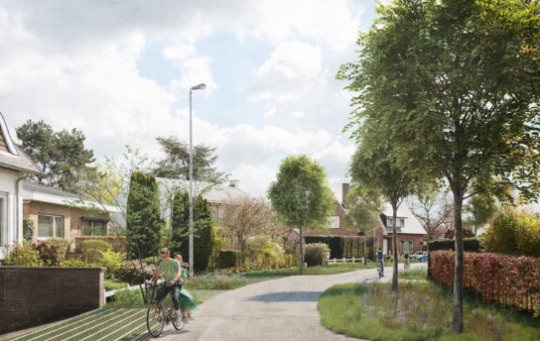
The residents opted for the maximum transformation plan
Streets change radically if they are given a climate-robust jacket. A pilot project in Leuven[1] proves how much further you can jump if the residents also believe in it.
The Spaanse Kroon (Spanish Crown) is a suburb in Leuven that still exudes the atmosphere of the 1970s: wide streets and sidewalks, large asphalt plains, single houses with driveways and front gardens. The district will undergo a metamorphosis from the end of next year. The sidewalks will be removed, the road will become narrower, green zones will be added, planting areas, 85 new trees and wadis - sunken places where rainwater will slowly seep into the ground. The entire neighbourhood becomes a living street.
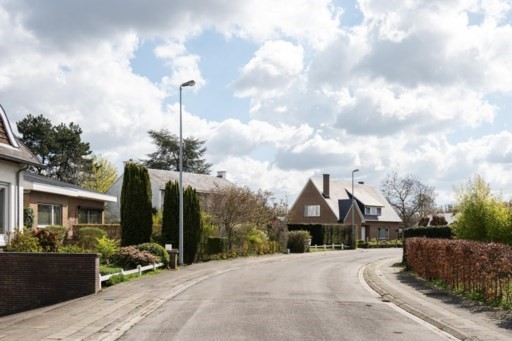
The neighbourhood as it is now
It is one of the six locations of Life Pact[2], a European project in which the city receives subsidies to accelerate adaptation in specific places. The lessons are bundled in a handbook that other cities can use. The central idea is that such an intervention works better if you include the inhabitants in the story. “We are working on an intensive participation process,” says project coordinator Baptist Vlaeminck. “We have been to the neighbourhood at various times. We have listened to the wishes and concerns of the residents, for example about the disappearance of parking spaces. With a temporary layout of planting areas and benches on the central square, we have given an idea of what is possible.”
Bird grove[3]
“In the end, we presented three adaptation scenarios: small, medium and large. The first two scenarios were much less drastic, with smaller trees and the preservation of one or both sidewalks. Nevertheless, the majority of the residents opted for the maximum scenario. Because there are still some concerns about safety due to the disappearance of sidewalks, we will make some adjustments to the design.”
At the same time, people are inspired to get started in their own garden. The Leuven Garden Rangers came by for free personal gardening advice, a group purchase of trees and other greenery is organised, there will be breakout and planting days, during which the city will have a waste container and tools brought in and neighbours can help each other. The city provides extra premiums for breaking out terraces and front gardens, and for the construction of a green roof or a rainwater tank. “If you hand it over on a silver platter, you can achieve a lot,” says Vlaeminck. “We also saw how neighbours started making plans together. Seven families will create a bird grove together at the back of their garden. Some residents are so enthusiastic that they urge their neighbours to join in. That is our intention: hoping that the city residents take over and that greening will be driven bottom-up.”
Source
Ine Renson, Leuven pioniert met omwenteling in woonwijk, in: De Standaard, 17-12-2022, https://www.standaard.be/cnt/dmf20221216_96979557
[1] Leuven (French: Louvain) is the capital and largest city of the province of Flemish Brabant in the Flemish Region of Belgium. It is located about 25 kilometres (16 miles) east of Brussels. The municipality itself comprises the historic city and the former neighbouring municipalities of Heverlee, Kessel-Lo, a part of Korbeek-Lo, Wilsele and Wijgmaal. It is the eighth largest city in Belgium, with more than 100,244 inhabitants. KU Leuven, Belgium's largest university, has its flagship campus in Leuven, which has been a university city since 1425.
[2] PACT stands for People-driven: Adapting Cities for Tomorrow. It is the ability of cities to deploy and improve nature-based solutions (NBS). In this way we can increase urban resilience and improve the health and well-being of citizens. https://www.leuven.be/en/about-pact
[3] A bird grove is a fairly dense, shrubby grove containing several (usually native) berry-bearing shrubs and trees.
0 notes
Text
Over half of humanity already lives in urban settings.

The need for development action in cities cannot be overlooked. Over half of humanity lives in urban settings, and this figure projected to rise to two thirds by 2050.
Incredibly, over half of humanity already lives in urban settings. With this figure projected to rise to two thirds by 2050, the need for development action in cities can no longer be overlooked.
0 notes
Photo

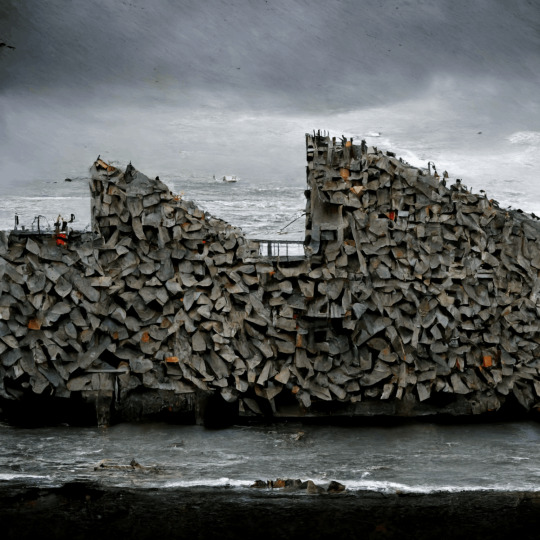


“Upcycled Collectives”
The project proposes an alternative architecture where construction debris up-cycling and mirco-climate systems work together to achieve architectural resilience in extreme weather conditions.
This approach argues for a "more is more" ethos; the accumulation of discrete leftover or refused material for its own sake. Reducing waste in landfills, local job sites and advocating for a radical change in our current waste and material supply chains while empowering local communities.
Erick Vernon-Galindo / Arch Hive
#art#design#Architecture#upcycle#concept#conceptual#sustainability#sustainable architecture#erick vernon-galindo#wood#debris#resilience#climate change#urbanism#arch hive
153 notes
·
View notes
Text
#urban heat#albedo#urban heat bubbles#environmentalism#good news#science#environment#global climate change#climate resilience
15 notes
·
View notes
Text
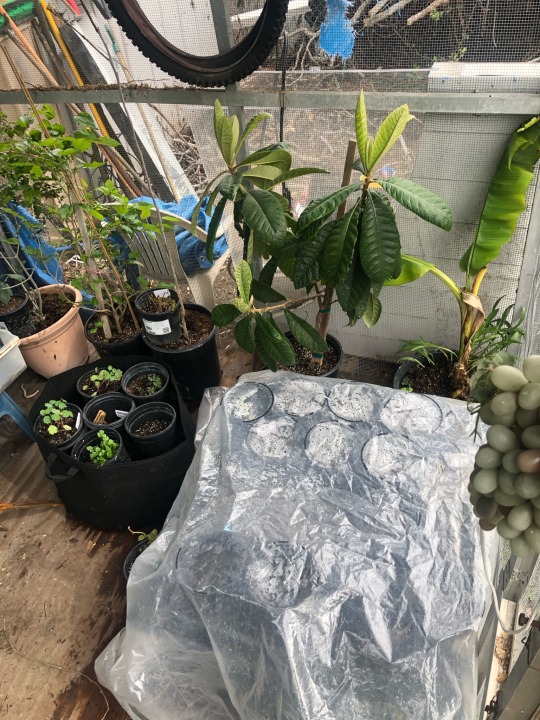

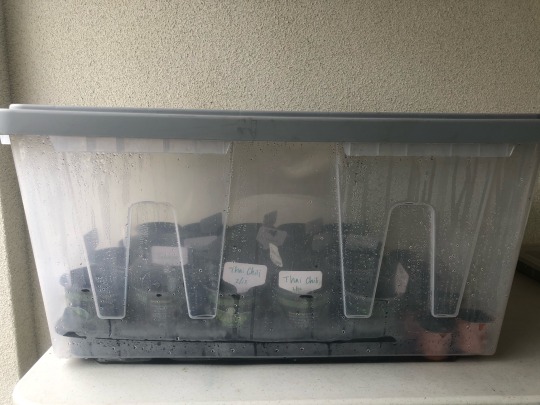

This is what my greenhouse at home looks like. I used to have more space and places to grow food for the community. Unfortunately, my growing spaces have been displaced so many times in the city. Land access is a privilege.
Urban farmers often don’t have their own farm. We use each others backyards and abandoned space on borrowed time.
Urban Soul Farmer
38 notes
·
View notes
Text
Chicago Fights Back: New Tools to Combat the City's Changing Climate
Chicago fights back against climate change with new sensor technology, helping neighborhoods adapt to a changing urban environment. #climatechange #sustainability #Chicago
Photo by heather bozman on Pexels.com
Chicago is no stranger to the impacts of climate change, with extreme weather, flooding, and heat waves becoming increasingly common in the city. To combat these effects, a team of 17 organizations, led by the U.S. Department of Energy’s Argonne National Laboratory, has deployed a set of scientific instruments on the rooftop of Bernard J. Brommel Hall at…

View On WordPress
#Chicago#climate change#community research#extreme weather#minority-serving institutions#resilience#sensor technology#sustainability#urban environment
11 notes
·
View notes
Text
Forests do more for the climate than store and sequester carbon.

For example, they:
regulate rainfall
provide cooling benefits
protect coastal areas
provide forest products for local communities facing climatic threats
#Adaptation services from forests#Adaptation and resilience from forests#ecosystem restoration#biodiversity conservation#integrated risk mamagement#water regulation#livelihood diversification#urban climate benefits#Protection from hazards#fao forestry#FAO CLIMATE#sdg15
2 notes
·
View notes
Text
Exploring the Impact of Modern Lifestyle on Indian Society
#Psychological Problems#Holistic well-being#Modern Lifestyle#Globalization#Mental health#Mindfulness#Creativity#Workplace stability#Traditional Values#Technology#Urbanization#Lifestyle#Community#festivals#relationships#social connectivity#personal development#healing magic#emotionally resilient#stress#reflection and renewal#music
2 notes
·
View notes
Text
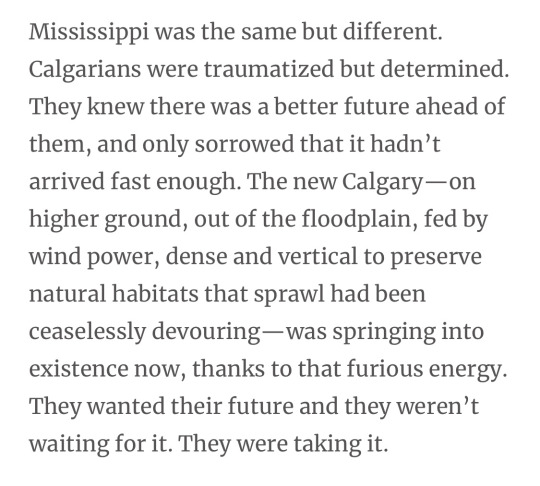
An excerpt from “The Canadian Miracle,” a short story set in the near-future of The Lost Cause, the new novel by Cory Doctorow ( @mostlysignssomeportents ).
As an ex-Calgarian I hope they build this future sooner rather than later.
2 notes
·
View notes
Text
High-Level Opening Ceremony of the Global Observance of the World Habitat Day 2023.
UN-Habitat, in partnership with the World Economic Forum, believes that these models can be localised and scaled up through the Global Partnership for Local Investment, where experiences are shared to build a local finance framework for cities and communities, to help distribute existing funding and finance to where it can deliver the greatest impact.
The local finance framework integrates three key solutions to facilitate this access:
Cities Investment Facility (CIF)
UN-Habitat/UNCDF Guarantee Facility for Sustainable Cities
Rapid Own Source Revenue Analysis (ROSRA)

PROGRAMME
Get the World Health Day 2023 Programme.
Watch the High-Level Opening Ceremony of the Global Observance of the World Habitat Day 2023.
#un-habitat#urban residents#resilient cities#urban development#urban recovery#urban resilence#Global Partnership for Local Investment#urban areas#World Habitat Day#Sustainable Cities#Cities Investment Facility (CIF)
2 notes
·
View notes
Text
Humans are so cute. They think they can outsmart birds. They place nasty metal spikes on rooftops and ledges to prevent birds from nesting there.
It’s a classic human trick known in urban design as “evil architecture”: designing a place in a way that’s meant to deter others. Think of the city benches you see segmented by bars to stop homeless people sleeping there.
But birds are genius rebels. Not only are they undeterred by evil architecture, they actually use it to their advantage, according to a new Dutch study published in the journal Deinsea.
Crows and magpies, it turns out, are learning to rip strips of anti-bird spikes off of buildings and use them to build their nests. It’s an incredible addition to the growing body of evidence about the intelligence of birds, so wrongly maligned as stupid that “bird-brained” is still commonly used as an insult...
Magpies also use anti-bird spikes for their nests. In 2021, a hospital patient in Antwerp, Belgium, looked out the window and noticed a huge magpie’s nest in a tree in the courtyard. Biologist Auke-Florian Hiemstra of Leiden-based Naturalis Biodiversity Center, one of the study’s authors, went to collect the nest and found that it was made out of 50 meters of anti-bird strips, containing no fewer than 1,500 metal spikes.
Hiemstra describes the magpie nest as “an impregnable fortress.”
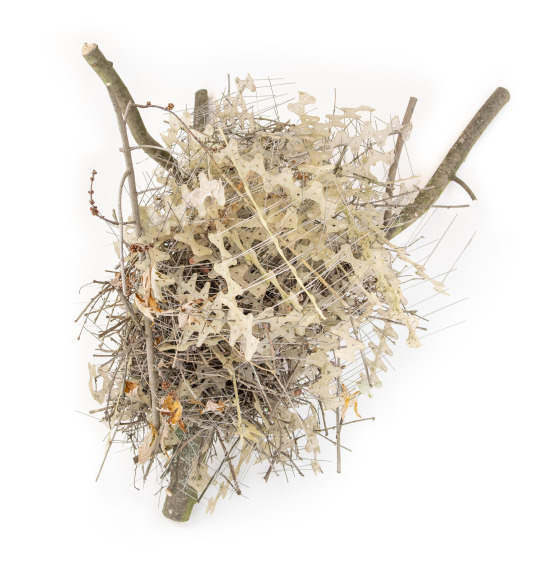
Pictured: A huge magpie nest made out of 1,500 metal spikes.
Magpies are known to build roofs over their nests to prevent other birds from stealing their eggs and young. Usually, they scrounge around in nature for thorny plants or spiky branches to form the roof. But city birds don’t need to search for the perfect branch — they can just use the anti-bird spikes that humans have so kindly put at their disposal.
“The magpies appear to be using the pins exactly the same way we do: to keep other birds away from their nest,” Hiemstra said.
Another urban magpie nest, this one from Scotland, really shows off the roof-building tactic:

Pictured: A nest from Scotland shows how urban magpies are using anti-bird spikes to construct a roof meant to protect their young and eggs from predators.
Birds had already been spotted using upward-pointing anti-bird spikes as foundations for nests. In 2016, the so-called Parkdale Pigeon became Twitter-famous for refusing to give up when humans removed her first nest and installed spikes on her chosen nesting site, the top of an LCD monitor on a subway platform in Melbourne. The avian architect rebelled and built an even better home there, using the spikes as a foundation to hold her nest more securely in place.
...Hiemstra’s study is the first to show that birds, adapting to city life, are learning to seek out and use our anti-bird spikes as their nesting material. Pretty badass, right?
The genius of birds — and other animals we underestimate
It’s a well-established fact that many bird species are highly intelligent. Members of the corvid family, which includes crows and magpies, are especially renowned for their smarts. Crows can solve complex puzzles, while magpies can pass the “mirror test” — the classic test that scientists use to determine if a species is self-aware.
Studies show that some birds have evolved cognitive skills similar to our own: They have amazing memories, remembering for months the thousands of different hiding places where they’ve stashed seeds, and they use their own experiences to predict the behavior of other birds, suggesting they’ve got some theory of mind.
And, as author Jennifer Ackerman details in The Genius of Birds, birds are brilliant at using tools. Black palm cockatoos use twigs as drumsticks, tapping out a beat on a tree trunk to get a female’s attention. Jays use sticks as spears to attack other birds...
Birds have also been known to use human tools to their advantage. When carrion crows want to crack a walnut, for example, they position the nut on a busy road, wait for a passing car to crush the shell, then swoop down to collect the nut and eat it. This behavior has been recorded several times in Japanese crows.
But what’s unique about Hiemstra’s study is that it shows birds using human tools, specifically designed to thwart birds’ plans, in order to thwart our plans instead. We humans try to keep birds away with spikes, and the birds — ingenious rebels that they are — retort: Thanks, humans!
-via Vox, July 26, 2023
#birds are literally learning how to better live/survive alongside us#this is like. actually kind of remarkable. and the technique is spreading including to other species.#is this hopepunk? it kinda feels like hopepunk to me.#animals are literally learning how to use our attempts to get rid of them against us#that's kind of amazing#and also VERY encouraging re: life's innate resilience#crows#magpie#corvid#crow#bird#bird nest#bird nerd#bird news#adaptation#urban animals#ornithology#climate adaptation#kinda#good news#hope#hope posting#hopepunk#animal intelligence#wildlife#animals are awesome
1K notes
·
View notes
Text

The Lonely Wanderer in Shadows of Ruined Glories
Amidst the crumbling remains of civilization, a solitary figure bravely ventured forward into the darkness. Cloaked in shadows, she wove her way through alleys devoid of life, where only rats scurried past mounds of rubble and broken dreams. Her eyes, adjusted to the dim light filtering down between collapsed buildings, took note of each discarded object - reminders of better days now long gone. This was not so much a place to survive anymore as it was a tomb of memorials marking humanity's demise. At some point along the treacherous path ahead, one could easily lose their sense of direction, the maze of destruction too vast and indiscriminate in its leveled desolation. But this traveler didn't stop searching; her resilience fueled her resolve to push deeper still, even if the odds seemed bleakest. For in the heart of this somber metropolis lurked secrets waiting patiently for someone intrepid enough to seek answers. And thus, our lonely wanderer soldiered on...alone in the shadow-shrouded ruins.
#Post Apocalyptic Cityscape#Urban Exploration#Desolate Architecture#Abandoned Urban Area#Destroyed Metropolis#Dark Ambiance#Human Resilience#Survivor in Wasteland#Dystopian Future#Adventure & Discovery#Stable Diffusion
4 notes
·
View notes
Text

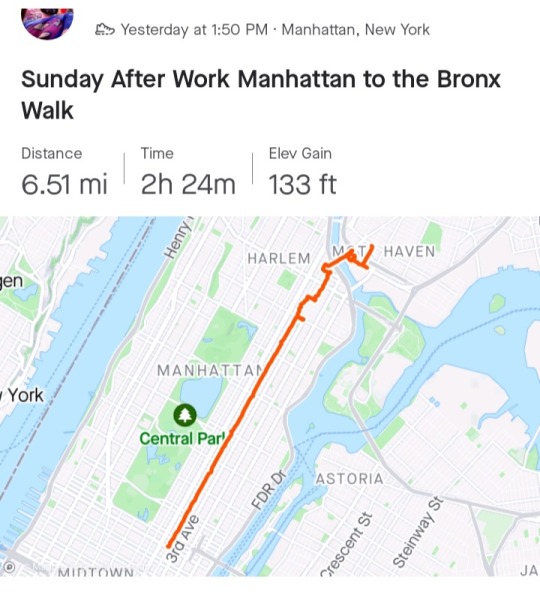
Yesterday marked a return to some rare stepping. It was a pleasant afternoon and I finished work relatively early so I decided to do one of my walkabout strolls around NYC. Sometimes one needs to be a tourist in one's hometown.
Starting at 57th and Lex, I walked north eventually crossing the Third Avenue Bridge into the Bronx and the ever-changing Mott Haven neighborhood. I finished at just under 30K. I resisted the urge to go back out and get the remaining 1.5K steps to go over 30K. I decided it was best to leave that ever rarer goal for another day.
Overall I walked 6.5 miles. It felt good and I feel strong today.
Have a great Monday everyone.
#Fitbit #FitbitVersa2 #UrbanStepping #Walking #WalkingisGood #WalkItOff #WalkingIsBetterThanTherapy #Fitness #Exercise #GetToStepping #AintNoHalfStepping #HereComesTheHotStepper #LeadByExample #Motivation #Success #Failure #Resilience #SiscoVanilla #SiscoVanillaIsStepping #SiscoVanillaHitsTheBricks #SiscoVanillaDeliversTheMail #HistorySisco
#Fitbit#Fitbit Versa 2#Urban Stepping#Walking#Walking is Good#Walk It Off#Walking Is Better Than Therapy#Fitness#Exercise#Get To Stepping#Ain't No Half Stepping#Here Comes the Hotstepper#Lead by Example#Motivation#Success#Failure#Resilience#SiscoVanilla#SiscoVanilla is Stepping#SiscoVanilla Hits the Bricks#SiscoVanilla Delivers the Mail
6 notes
·
View notes
Text

© Paolo Dala
Portraits Of Resilience
The world breaks everyone, and afterward, some are strong at the broken places
Ernest Hemingway
#Ernest Hemingway#Resilience#War#People#Destruction#Urban#City#Marawi City#Lanao del Sur#Philippines
1 note
·
View note
Text
reminder that native plant purity kills opportunities for urban horticulture
#i'm a horticulture major with a huge hard on for native plants and resilient landscapes#and a lot of urban landscapes need non-native plants to be resilient#trees that can survive with few resources and not enough space and high reflective heat#plants that don't need the same number of cold days for germination#plants that can fill in the particular niche and food source of natives that get decimated by non-native pests that make it to the area#(of course we have to keep out invasives because they don't do anyone any good)#(don't take this as me promoting invasives)#species diversity is so important#arguably moreso than native purity#environments are so entirely different today than they were when the majority of “native” plants evolved#those plants might be native to the area#but not to the conditions and the current environments#of where we're trying to place them#so while yes#it's important that we continue planting natives in order to promote native insect/bird/mammal/etc. species#like planting your native milkweed for monarchs and other species#planting a wide diversity of plants is crazy important#also our human built environments also should be satisfying to HUMANS#so you can build your natives only landscapes and shit#and some will be done crazy fucking well and beautifully#but if we want people to plant more and engage more with the environment then we have to cater to everybody's desires for their environment#and if that requires a mix of native and non-native plants#useful and “useless”#tidy and messy#then so fucking be it#sorry i'm a landscape design major and I have VERY strong feelings about this#very strong feelings about many things relating to plants in urban and residential environments#do NOT mistake me for one of those boring-ass copy-paste companies though i'll kms
3 notes
·
View notes